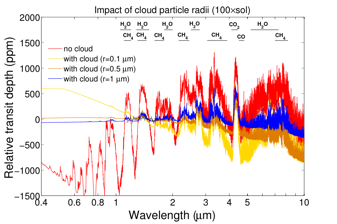2015 Annual Science Report
 VPL at University of Washington
Reporting | JAN 2015 – DEC 2015
VPL at University of Washington
Reporting | JAN 2015 – DEC 2015
Charnay NAI NPP PostDoc Report
Project Summary
My project focuses on the modeling of clouds and photochemical haze in the atmospheres of the early Earth and exoplanets. I use a 3D model, developed to simulate any kind of atmosphere, to study the formation, dynamics, climatic impact and observational features of clouds/haze. My first object of interest is GJ1214b, a mini-Neptune whose observations by HST revealed a cloudy/hazy atmosphere. The formation of such high and thick clouds is not understood. My second object of interest is the Archean Earth for periods with a methane-rich atmosphere leading to the formation of organic haze.
Project Progress
This document reports on activities during the year 2015 as an NAI/NPP postdoctoral Fellow (started in August 2014) at the VPL. During this time, I finished my work on the clouds on the exoplanet GJ1214b. Using the Generic LMD GCM, I showed that the circulation is strong enough to transport micrometric KCl and ZnS cloud particles to the upper atmosphere (Charnay et al., 2015a), producing the flat spectrum observed by the Hubble Space Telescope (Charnay et al., 2015b; see Figure 1).

I also showed that future telescopes (in particular JWST) should be able to detect molecules and estimate the mean atmospheric composition by observing in the mid-infrared. This work constitutes the first 3D simulations of clouds on a warm exoplanet and is of prime interest for the preparation of future space telescopes. I published this work in two papers, the first one is focused on the atmospheric dynamics and vertical mixing (Charnay et al., 2015a), the second one is focused on cloud distribution and observational impact (Charnay et al., 2015b). I presented this work at the DPS meeting in November 2015 and at the Extreme Solar System meeting in December 2015. I am planning for next months to study the formation of photochemical haze (rather than the condensate clouds I studied in my two previous papers) in the atmosphere of GJ1214b and other warm mini-Neptunes. I participated in a study on the possibility of identifying Earth-like planets from direct imaging using colors (Krissansen-Totton et al., 2016). For this study, I provided spectra of mini-Neptunes, based on my work on GJ1214b.
In parallel to this work on GJ1214b, I published a paper in Nature Geoscience on the formation of Titan’s dunes by methane storms (Charnay et al., 2015c). I did most of this work during my PhD but I finished it during my NPP postdoc. I proposed a new mechanism to the formation of Titan’s dunes by methane storms, solving the long standing mystery of the eastward propagation of dunes. The Cassini spacecraft has detected dust storms. I provided a mechanism to their formation thanks to methane storms. I am coauthor on a submitted paper that describes these observations.
I am currently working on the climates of the early Earth during the Hadean using the Generic LMD GCM with potentially high amounts of CO2 (up to 1 bar). A paper describing the climate and the carbon cycle during the Hadean is in preparation. I also used the GCM to compute lightning on the early Earth. The results of my simulations have been used by VPL researchers at Caltech to study the production by lightning of NOx molecules, which are important for the development of life. I am second author on a paper describing these results and submitted to Astrobiology.
For the next months, I planning to study the impact of atmospheric escape on the composition of mini-Neptunes and in particular the trapping of condensable species for planets experiencing a strong hydrodynamic escape. I will also collaborate on a study on the recently discovered super-Earth GJ1132b. I will produce 3D simulations of the atmosphere of this planet to predict the future observations by JWST. In addition, I am planning to study with the 3D GCM the formation and climatic impact of organic haze on the early Earth.
Publications
-
Charnay, B., Barth, E., Rafkin, S., Narteau, C., Lebonnois, S., Rodriguez, S., … Lucas, A. (2015). Methane storms as a driver of Titan’s dune orientation. Nature Geosci, 8(5), 362–366. doi:10.1038/ngeo2406
-
Charnay, B., Meadows, V., & Leconte, J. (2015). 3D MODELING OF GJ1214B’S ATMOSPHERE: VERTICAL MIXING DRIVEN BY AN ANTI-HADLEY CIRCULATION. The Astrophysical Journal, 813(1), 15. doi:10.1088/0004-637x/813/1/15
-
Charnay, B., Meadows, V., Misra, A., Leconte, J., & Arney, G. (2015). 3D MODELING OF GJ1214b’s ATMOSPHERE: FORMATION OF INHOMOGENEOUS HIGH CLOUDS AND OBSERVATIONAL IMPLICATIONS. The Astrophysical Journal, 813(1), L1. doi:10.1088/2041-8205/813/1/l1
-
Krissansen-Totton, J., Schwieterman, E. W., Charnay, B., Arney, G., Robinson, T. D., Meadows, V., & Catling, D. C. (2016). IS THE PALE BLUE DOT UNIQUE? OPTIMIZED PHOTOMETRIC BANDS FOR IDENTIFYING EARTH-LIKE EXOPLANETS. The Astrophysical Journal, 817(1), 31. doi:10.3847/0004-637x/817/1/31
-
PROJECT INVESTIGATORS:
-
PROJECT MEMBERS:
David Catling
Co-Investigator
Victoria Meadows
Co-Investigator
-
RELATED OBJECTIVES:
Objective 1.2
Indirect and direct astronomical observations of extrasolar habitable planets.
Objective 4.1
Earth's early biosphere.
